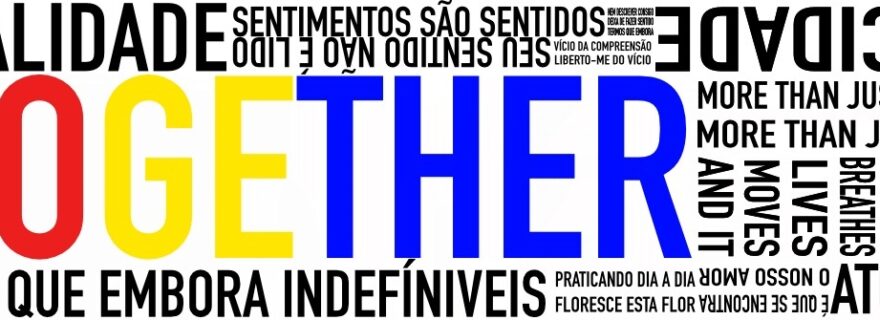You and I together
Morality is something we do together. This is the underlying topic of the recently released song You and I Together, which explores the notion that–even though we are not able to articulate abstract terms like ‘good’, ‘bad’, ‘truth’ or ‘friendship’–we express our understanding through our actions.
The mixture of Portuguese and English lyrics encapsulates the transitivity of these morals across different cultures. The video clip further illustrates this by depicting the story of a character whose life is shaped by his moral choices.
The lyrics were inspired by a series of discussions I had with my dear friend Guido. Having gone back and forth on what morality is, we decided to expand our discussion by creating a weekly meeting group about the topic.
Unfortunately, these were marked mostly by shouting and cross-talking, somewhat mirroring Carnap’s account in his auto biography where he expressed the depression caused by “disputations in which the opponents talked at cross purposes; there seemed hardly any chance of mutual understanding, let alone of agreement, because there was not even a common criterion for deciding the controversy.”[1]
Now and then, however, we would have moments of clarity.
One of these moments concerned the question of nature versus nurture. Of course morality has a cultural imprint. A recent open-source experiment on the famous trolley dilemma, for example, showed that certain cultures prioritized saving the elderly far more than others. The more contentious issue around the Humanities Faculty, however, is: To what extent is culture biologically determined?
Once we look past dogmatic views of biological determinism, this view holds very plausible points. After all, we are biological beings, so any behavior we exhibit must have a biological substratum.
Neuroscientist António Damásio puts it elegantly: “genes provide for one brain component with precise structure, and for another component in which the precise structure is to be determined. But the to-be-determined (tbd) structure can be achieved only under the influence of three elements:
- the precise structure” that is to say, you can never completely divorce the tbd structure from its development, hence, there are limits to what culture can alter;
- “individual activity and circumstances,” this is where culture and subjective circumstance comes in of course; and
- “self-organising pressures arising from the sheer complexity of the system” – that is to say, after the back and forth between determined structure and cultural/individual input, there is a third step of re-configuring the information, which is, itself, biologically driven.[2]
What is the interaction between these two influences though? Noam Chomsky’s work on linguistics serves as the best analogy I have found, an analogy that John Rawls and later John Mikhail went on to explore. Chomsky argues that language is a mental faculty which develops through the indispensable combination of external input and internal mechanism.
It’s external because without any input, i.e. contact with language, it is impossible to learn language. The few cases of ‘Tarzan children’, children that were raised in wild environments, are the prime examples. They did not have the linguistic input at a certain key age and so never developed the language faculty. It’s internal because without any hard-wired imprint, you cannot learn a language. Try teaching your pets how to speak, and you’ll quickly see what is meant.
Similarly, morality is both external and internal. The analogy we employed is that of a grid. A grid is a fixed structure, which cannot be changed. That is the biological implant of morality. The contents within this grid, however, are developed through our contact with the environment. Some grids will be filled out to prioritize elderly over the young, and vice-versa.
However, because it is a grid, there is a limit to what we find moral. Not anything goes. Sure, we find differences in cultures, but within certain limits. The difficulty is to articulate those limits. But we found some compelling ones. For instance, you will not find anyone who thinks slaughtering their children is the path to moral righteousness.
This is not to say that nobody will act in this extreme way. Sure, you might find the odd freak who does actually perpetrate these actions. However, actions are not a sufficient metric for defining morality. For instance, most of us would agree that one should not treat others in ways that one would not like to be treated. Unfortunately, however, that is not always what we do. Our actions do not always align with our morals.
Importantly, however, it is not an instance that disproves our thoughts about structural limits to morality. It merely shows that humans are not perfectly moral creatures. Which should hardly come as a surprise.
In brief, morality–like any other biological feature we have–is shaped by the environment we live in. This development, however, is guided by a hard-wired imprint, much like a digestion system is affected by the nutrients it is put in contact with, but will always become a digestive system. Morality will always become morality. And how do we show that we are moral? Through our actions.
But then it seems we have a paradox! Actions are not sufficient to disprove morality, yet it is through them that we show our morals? Yup, we don’t really understand it either. Perhaps this whole question is slightly over our heads. But that’s why I wrote a song about it instead (click the video below). That way, we can dance and sing to the sound of morality.
[1] Rudolf Carnap, “Intellectual Autobiography”, in: Paul Arthur Schilpp (ed.), The Philosophy of Ru- dolf Carnap (Chicago 1963) 1–84: 45.
[2] Antonio Damasio, Descartes Error: Emotion, Reason and the Human Brain, (Vintage Books, London): 111.
You and I Together
